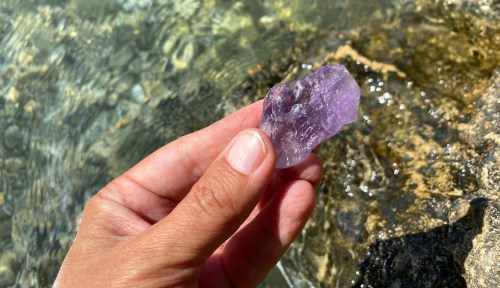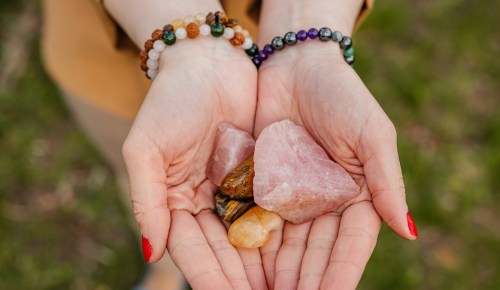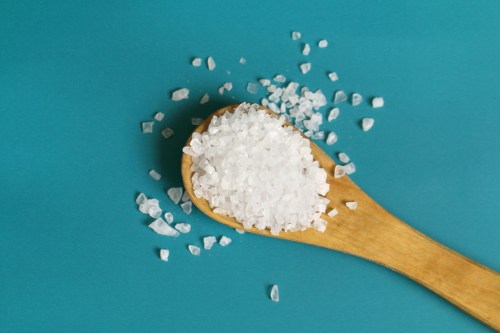As an astrologer and nature lover, it doesn’t come as much of a surprise that I collect crystals and gemstones like they’re going out of style. Growing up, vacation trips to the Smoky Mountains always ended in a stop at the gift shop, where I would gleefully sift through colorful stones to take with me as a keepsake. As an adult, I still become downright giddy when I’m gifted rose quartz or a stunning amethyst crystal to display in my home. If you share my fascination with gemstones, you might be wondering where to find crystals in nature. Allow me to explain.
Experts in This Article
a geologist with a BS in Geology, 
The crystal collecting community has seen an uptick in recent years, with some crystal owners seeing the price of their treasures double in 2020. Lydia Huffman, a geologist with a BS in Geology, who currently works in the gemology field, says there could be a good reason for this. “While they’ve been appreciated by us for thousands of years, I believe the reason more people are starting to build a love for crystals in recent years is because of the rise of social media and spirituality during Covid.” Huffman says, “During that time, we saw so many people being able to find new interests through social media—thanks to the increase in free time—and crystal collecting is one of the hobbies that really skyrocketed.”
“It’s undeniable that crystals have a unique beauty that’s captivating to us.” —Lydia Huffman, a geologist with a BS in Geology
Of course, every crystal-lover has their own reasons for being interested in the gems. “No matter what the intended use of it being, whether that’s for spirituality or decor or science, it’s undeniable that crystals have a unique beauty that’s captivating to us.” Especially in terms of holistic practice, many believe that crystals hold mystic properties and can even be used to promote or accelerate healing. A 2009 study on gemstone therapy1 in Pakistan showed that more than half of the sample size was aware of the use of gemstones in therapeutic settings, with many believing the gems held some impact on health. Some people believe “charging” their crystals under the sun or moonlight can increase healing potential, others turn to gemstones for protection, and some even use crystal pendulums to help guide their decisions.
Regardless of your reason for seeking out crystals, one thing is certain: while it’s easier to come across gems or crystals in-store or online, nothing beats procuring a gemstone from the earth yourself. Recreational, or independent, crystal mining has been in practice for years, drawing plenty of “rockhounds” to mining sites across the globe in hopes of finding “buried treasure.” While you may not want to quit your day job over the slim chance you’ll strike it rich by finding some extremely rare stones, it is the perfect hobby for an avid crystal collector who prefers a more scenic, adventurous experience to grow their collection.
If you’re not quite ready to rummage through your backyard, though, there are still options for you to learn how to start collecting gems and where to find crystals. Read on below to learn more about crystals, where to find crystals near you, and to learn more about some of the most popular public mines to start your crystal mining journey.
What is the difference between a crystal and a rock?
If you think the terms “crystal” and “rock” can be used interchangeably, it’s not quite that simple. According to Huffman, a crystal must meet specific requirements: Crystals are “naturally occurring, solid, have a definite structure, and a specific chemical composition.” For example, Huffman points out that quartz is a crystal because it “will always be made with the same compound: silicon and two oxygen elements.” So, what makes this different than a rock? “A rock, on the other hand, does not have an exact structure and composition. Rather, it is a mix of minerals, dirt, or even organic matter,” Huffman clarifies.
Of course, if you think a rock looks cool or might be worth adding to your collection, don’t let it stop you—it may not be a crystal but it’s still valuable. It’s still worth knowing what you’re collecting, though, so we asked Huffman exactly how—and where—to find the real deal.
Where are crystals most commonly found?
You may think crystals can only be found in very specific locations, but Huffman says that’s not entirely the case, at least geographically speaking. “There is no set area/geological location that will have a higher likelihood of having crystals; however, they’re much more likely to be spotted in areas that aren’t taken over by plant matter.” In other words, there are some places where it might be easier to see the crystals you’re hunting. “You’re much more likely to be able to find minerals [at the surface] in riverbeds, streams, or creaks and along their floodplains because any debris, like sediment or organic matter, has been swept away by the moving water.”
Seeing crystals isn’t the same as collecting them, though. So, if you’re looking to get your hands on some gemstones, you might want to start in your own backyard. “Whenever I’ve posted my ‘crystal hunting in my backyard’ videos on social media, I’ve been flooded with people astonished by how many crystals I’ve been able to find,” Huffman shared. hat’s not because of my skill level, but rather the fact that the construction of my house—which was built fairly recently—resulted in the removal of the first few feet of soil with no [plant life] to cover the minerals that were left.” So, the only thing standing between you and your first successful crystal hunt might be a few feet of dirt.

If you want to dig a little deeper, you may wish to search for mineral veins, a layer of ore between sheets of rock, to find certain crystals. While it’s not impossible, Huffman admits it isn’t quite as easy as searching for crystals closer to the surface. “When it comes to finding veins underground, it can be very difficult without the proper technology that can read or map the subsurface.” If you’re determined to try, she does have a tip: “You can often find smaller mineral pieces at the surface that act like breadcrumbs to its source. Sometimes, you may be able to find surface pockets that look like little holes in the ground, which can be an indicator of a vein.”
While you can find crystals in plenty of locations, it’s also important to keep in mind what specific types of minerals and gemstones you’re hoping to find. Some specific gems may be easier to unearth in certain locations. For example, you’ll have a higher likelihood of securing opal gemstones in states like Nevada, Oregon, and Idaho. Many mines, however, offer a variety of crystals at their locations. Still, it’s best to do your research to find the best locations for the exact crystals you’re after.
What do you need to dig for crystals?
If you’re new to crystal mining, the good news is you won’t need a plethora of fancy tools to get the job done. “Whether you’re looking for minerals at the surface or planning on doing a more intensive search, I highly recommend bringing a shovel, pickaxe, and gloves,” says Huffman. She carries a smaller version of each tool—a small pickaxe and a gardening shovel—which can easily be tucked away in a bag or hung from a belt loop. “These two tools make it easier to [uncover] more stubborn minerals out that may be partially buried,” Huffman explains. “What I tend to do is shovel the dirt away from the surrounding area of the crystal and pry it out of the earth using the pickaxe.”
As far as clothing, Huffman suggests wearing something similar to hiking attire. It’s also a good idea to wear clothes you don’t mind getting dirty, as you’ll likely be digging around in dirt and debris on your hands and knees. As for shoes, she specifically recommends wearing hiking boots, as you’ll likely be walking across uneven terrain that can be hard on your ankles.
Finally, keep safety in mind when you’re thinking about where to find crystals, especially in unfamiliar territories. “Make sure always to use safe practices such as knowing your physical boundaries and sharing your location with friends and family in case of an emergency,” Huffman advises.
Why are crystals becoming so popular?
If you live in or near a well-populated city, your chances of coming across crystals in a local store are pretty high considering how popular crystals have become in recent years; plus, you can always shop them online. So why do some people prefer to track down the gems themselves? It’s no secret that humans have been mining gemstones for thousands of years—gemstones such as the emerald were mined in Egypt as early as 330 B.C., according to the American Gem Society. Once more sophisticated machinery and technology came into play around the 1800s, humans a more commercialized process of hunting gems began.
“There are spectacular specimens that can be found in every state; you just have to find them!” —Lydia Huffman, a geologist with a BS in Geology
Today, recreational gem mining captures the attention of individuals for a few reasons. Many find they enjoy the act of searching for something, even if they don’t find many crystals in the process. Some gather groups of friends and enjoy the camaraderie of being outdoors together. Collectors may long to find certain types of crystals to fill out a collection, while more casual crystal fans may look for specific types to turn into jewelry or that hold special value to them, such as birthstones. There are multiple reasons to make crystal hunting your new favorite hobby, but exactly what makes the outdoor hobby so compelling is for you to decide.
Where is the best place to dig for crystals?
If you’re wondering exactly where to find crystals, plenty of gem mines are open to the public, some with or without reservation. “There are spectacular specimens that can be found in every state; you just have to find them!” says Huffman. If you’ve already scoured your backyard or you’re looking for a more scenic place to start, though, here are nine worthwhile gemstone mining destinations to help you hit the ground running.
Emerald Hollow Mine—Hiddenite, North Carolina
If you’re looking for rare crystal finds, Emerald Hollow Mine in Hiddenite, North Carolina, has the treasure trove you’re looking for. Emerald Hollow is the only emerald mine in the world open to the public. Described as a “geological freak of nature,” there are plenty of potential gems to discover here, including sapphire, aquamarine, garnet, topaz, and amethyst. In 2009, one man discovered a 310-carat emerald, per CNN. It’s also worth noting that this is the only mine in the world where you can find authentic hiddenite, the fourth-rarest gemstone in existence.
The mine offers three ways to obtain crystals: sluicing, creeking, and digging. Sluicing allows you to sift through a bucket enriched with gemstones, guaranteeing you’ll find a few crystals (buckets range in size and price). Creeking is for those who want a slightly more adventurous and scenic experience—water flows down a creek that you can easily search for precious gems—though, you aren’t guaranteed success. For those who really want to get their hands dirty, the final option allows you to hike to the mine and dig around. Prices start at $10 for children and $25 for adults.
If you want to turn your treasure into a wearable keepsake, the mine also has a lapidary—a gem polisher and engraver—on the premises that can transform your finds into stunning jewelry.
Craters of Diamonds State Park—Murfreesboro, Arkansas
For those searching for diamonds, Craters of Diamonds State Park in Murfreesboro, Arkansas, is North America’s only public diamond mine and is located on the surface of a volcano crater. Any diamonds or gems—which come in a variety of shades of white, brown, and yellow—you find during your search are yours to keep, as well as other jewels such as amethyst, garnet, jasper, agate, and quartz. In fact, the largest diamond ever unearthed in the US—a whopping 40.23 carats—was discovered at this location.
You have a few options for diamond-searching here. The first involves walking through the 37.5-acre area looking for gems by sight—ideally, you have better chances of success after it’s rained. The next option involves digging and sifting, though you can only dig six inches or so into the ground. The final option for experienced miners involves digging deeper holes and intently sifting through the dirt. None of these methods guarantee results; however, it’s worth the adventure to try your luck. The entry fee for any of these options is $10 per person, and you can bring your own tools or rent tools from onsite.
Jade Cove—Big Sur, California
Unlike other destinations on this list, Jade Cove, located in Big Sur, California, is not a commercialized mine—it’s geared towards the avid, more experienced hiker. Jade Cove is free to the public and is named after the Monterey jade that can be found in the area. For those hoping to snatch up valuable jade pieces to make some extra cash, however, most of the larger pieces have already been harvested by jade hunters in the past. It’s still possible, though, to find smaller jade pieces and a few other minerals by searching on land during lower tides.
There are a few precautions to keep in mind while visiting Jade Cove. The trails aren’t recommended for inexperienced, easy-going hikers, as the pathways can be dangerously steep and require rope assistance. Additionally, plenty of regulations restrict jade and gem sourcing, so don’t expect to walk away with a large haul. Weather is also a significant factor—visiting during low tides is recommended to avoid slippery rocks and life-threatening tidal waves.
Despite the risks, tourists and jade seekers alike regularly visit Jade Cove in search of the gem in shades of green, red, black, blue, and brown—there’s even an annual Jade Festival!
Graves Mountain—Lincolnton, Georgia
Grave Mountain, tucked away in Lincolnton, Georgia, was first mined in the 1920s by Tiffany and Co., specifically for the rutile—or titanium dioxide—substance used to polish diamonds. The mine still produces some of the finest rutile crystals in the world. Despite the small locale, the area is a sought-after tourist spot.
These days, Graves Mountain is accessed by appointment only, with a notable exception: the caretaker, Junior, hosts two annual “rock swap and digs” in May and October. Each event lasts three days and is open to the public from 8 a.m. to 6 p.m., with food available for purchase. The mountain boasts gems such as iridescent hematite, pyrite, quartz, and other crystals. Entry for the public events is by donation, making it an affordable and accessible mining experience.
Cherokee Ruby & Sapphire Mine—Franklin, North Carolina
The Cherokee Ruby & Sapphire Mine in Franklin, North Carolina, has plenty of gems on its premises. What makes this gem mining location unique, though, is the rare pigeon-blood ruby—a remarkably large one sold at auction in 2015 for $33 million, according to Daily Mail. The mine claims this is one of two locations in the world where the gem can be uncovered, with the other being the country of Burma.
Sifting through the unsalted buckets also yields many other crystals and gems. Sapphires, moonstones, quartz, smokey quartz, and, yes, plenty of rubies await those willing to make the journey. The mines are open from March through December but will close during inclement weather. It’s advised to call ahead to ensure the mine will be open if weather conditions seem unfavorable. Admission is $35 per person and includes two buckets, with more available to purchase for an additional fee.
Wegner Quartz Crystal Mine—Mount Ida, Arkansas
For those wondering where to find crystals like quartz, look no further than Wegner Quartz Crystal Mine in Arkansas. While quartz is more than abundant, the property specializes in rare and unusual types of gemstones, such as phantom—a crystal trapped inside another crystal—and smokey varieties. “I’ve known fellow miners who had great experiences in Wegner Crystal Mines,” says Huffman.
There are five different methods for finding gems at Wegner, including:
- Crystal Forest Mine: a 40-acre open pit surface mine where you can collect crystals found at the surface—these gems are especially visible after a rain—or dig deeper into visible veins.
- Phantom Mine: Wegner’s most popular attraction, only available to groups on weekends and by appointment, allows digging specifically for phantom quartz and other high-grade quality quartz types.
- Tailings Area: A large open space where gemstone hunters can sift through piles of dirt brought in weekly that contain various gems; this is an easy-to-access option for families.
- Gemstone Sluice: A 100-foot-long sluice, or screen, where a pail of dirt is provided to pour through the sluice and discover gemstones contained in each bucket.
- Diamond Experience: A small pouch is provided that is guaranteed to contain at least ½ carats worth of diamonds. Visitors sift through the gravel-filled pouch to find the diamonds. (Worth noting: these diamonds aren’t local to the mine but are sourced from Congo, Africa)
Fees start at around $11 per person, with discount packages available for multiple activities.

Rainbow Ridge Opal Mine—Virgin Valley, Nevada
If decadent opal gemstones are more your speed, it’s difficult to find a better location than Rainbow Ridge Opal Mine in Nevada. Opals are sought after for their vivid and striking colors, and in 1905, the first of these stones were found in the Virgin Valley. It’s become a sought-after destination ever since.
There are two mining options at Rainbow Ridge, albeit they are pricier than other locations on this list. The first is the Tailings option, which refers to material that has been previously mined but still contains plenty of “clods” that contain opals. Tailings are dumped into an area, and visitors can sift through the rubble to find clods to pick apart with tools. The second is the Virgin Ground Roads option, which allows you to search for material that has yet to be previously mined and includes clay clods reported to be as large as a microwave oven. A load is reserved for each group and can keep a few adults busy for an entire day. Those who finish the Virgin Ground Roads experience early, however, can also participate in the Trailings option for a fee.
Trailings are $100 per person, with children 10-15 accompanied by an adult admitted for half-price. These experiences do not require a reservation. Virgin Ground Roads options cost $900 for up to three adults, with halfloads occasionally available for $600 with a reservation.
Herkimer Diamond Mines—Herkimer, New York
Despite the name, the Herkimer Diamond Mines in Herkimer, New York, aren’t filled with actual diamonds. The property boasts a specific type of double-terminated quartz crystal, referred to as Herkimer Diamond, that is remarkably similar to diamonds in appearance and durability. With the ongoing high demand for true diamonds, which causes a great deal of environmental and sustainability issues, Herkimer diamonds are an ideal substitute because they have less of a negative environmental impact and, to the average eye, they look identical to the real thing.
There are two mining options here: an above-ground surface mine, where visitors can sort through and use tools, such as a hammer, to smash open rocks and reveal quartz treasures throughout the area, and sluicing, which involves taking a bag to a sluice station and sifting through screens to reveal remarkable gems. Once you’ve found your crystals, you can take them to the on-site Artisan center to create jewelry from your finds as a unique keepsake.
Monday through Thursday, admission fees are $18 for anyone age 13 and up, with prices hiking up to $20 per person Friday through Sunday. This fee includes an all-day prospecting ticket, gem collection bags, and the use of a rock hammer to help you dig up a few natural treasures. Children age five to 12 can also be admitted for a discounted price of $14, while children four and under are allowed free entry.
Crystal Park in Beaverhead National Forest—Polaris, Montana
“Crystal Park in Beaverhead National Forest holds stunning quartz varieties like amethyst and smokey quartz, making it a top pick with independent miners,” Huffman says of the crystal hunting site. Crystal Park allows visitors to mine a 30-acre site using hand tools only—commercial digging is not allowed. The entry fee is comparably very affordable at $5, but strict rules are enforced for visitors. Some rules include an imposed digging limit of five days per person each year and restrictions on specific areas that must be avoided when excavating any discovered crystals.
What are the negative effects of gemstone mining?
Crystal mining sounds like a unique and fun experience—but is it good for the environment? Huffman says in most cases, independent recreational gem mining isn’t something to stress yourself out over in terms of the environmental impact. “When it comes to independent/hobby mining, there are little negative effects you can impose on your local ecology, as long as you practice leaving no trace.” A few ways to practice “no trace” policies include not littering, cleaning up after yourself, and respecting the wildlife. You want to leave the area as similar to the way it was when you found it as possible.
Huffman implores, however, that if you participate in recreational mining, you’re aware of and bring attention to the environmental impacts of commercial mining, which has dire consequences. “The high demand for ores and metals—such as cobalt, and precious minerals, like diamonds—has led many to be forced into labor under dangerous, and possibly fatal, conditions,” she explains, as supported by this 2021 study2 on the Democratic Republic of Congo. “Environmentally, commercial mining can lead to deforestation, habitat loss, water pollution, and numerous other factors that need to be addressed.”
Final thoughts
If you were wondering where to find crystals, these mines are just a drop in the bucket of locations to get your hands dirty and dig up some gemstones. For anyone looking for more local gemstone mining locations, Huffman says crystals could be closer than you realize. “I highly recommend utilizing Mindat, which is a mineral database, for anyone—no matter your experience level—when looking into what minerals you could possibly find within your area. All you need to do is search the city or region you’re in, and it will provide you with a list of minerals found there!” Huffman also recommends seeking out hobby-mining social media groups and organizations in your area. Whether you’re collecting crystals for their aesthetic, spiritual connection, or value, mining for gemstones is a unique experience you don’t want to miss.
- Ishaque, Sidra et al. “Knowledge, attitudes and practices regarding gemstone therapeutics in a selected adult population in Pakistan.” BMC complementary and alternative medicine vol. 9 32. 26 Aug. 2009, doi:10.1186/1472-6882-9-32↩︎
- Galli, Nikolas et al. “Socio-environmental impacts of diamond mining areas in the Democratic Republic of Congo.” The Science of the total environment vol. 810 (2022): 152037. doi:10.1016/j.scitotenv.2021.152037↩︎
Sign Up for Our Daily Newsletter
Get all the latest in wellness, trends, food, fitness, beauty, and more delivered right to your inbox.
Got it, you've been added to our email list.











